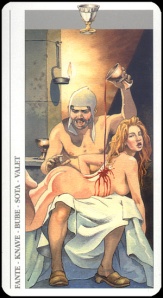Mystical Experiments Begin With Observation
(Copyright Talmage Carawan, 2013; for rights reserved and permitted, see the post entitled “New Publications”)
Reading Cloth for Ciro Marchetti’s Oracle of Vision
Mystical Experiments, as do all experiments, begin With observation. In reading Jung, it is impossible to overlook his interest in symbols, religions, dreams, and all factors of life, building extensively, both outwards and inwards, from the more focused on the sexual, as often preoccupied Freud.
There is something very important to add here, before going further. While Jung opened up the world of dream analysis and psychological therapy to a much wider audience, attaching too much significance to the symbols must be guarded. In “On the Nature of Dreams,” Jung wrote that to interpret dreams, it is required on the part of the analyst to possess
“psychological empathy, ability to coordinate, intuition, knowledge of the world and of men, and above all a special ‘canniness’ which depends on wide understanding as well as on a certain ‘intelligence du coeur.'”
To further put simplistic explanations in perspective, he stated:
“No sixth sense is needed to understand dreams. But more is required than routine recipes such as are found in vulgar little dreambooks, or which invariably develop under the influence of preconceived notions. Stereotyped interpretations of dream-motifs is to be avoided; the only justifiable interpretations are those reached through a painstaking examination of the context.”
So, we must be careful not to rely on simplistic interpretations, despite the appeal of an easy interpretation, or as I have found in this “experiment,” being attracted by the artwork of well crafted tarot decks. However, we keep an open mind and take a look, seeking some neutrality and objectivity. We refrain here from a critique of many websites that one might be lured to when searching for dream analysis, which offer easy answers with too little thought; Jung’s warning about vulgarity and preconceived notions will suffice.
Moving on the sometimes parallel and sometimes intertwining paths of science and the Dharma, I rather passed by many of the symbols and rituals that had not escaped Jung. The Tarot was something which had interested me primarily in the art of the cards, and not having dwelled but for a very brief period of time (when I had a relationship with a woman interested in all things pagan, particularly wicca), on the related aspects of divination and astrology, largely passed by.
Several of Jung’s texts drew me to rethinking aspects of Tarot and the associated symbols and, to give it some label of differentiation, “mystical” pursuits. I decided to take as unbiased an approach as I could to the cards and their interpretation, making observations that might lead to experiments with the cards. Observations are readily made, in several areas.
Searching for a deck with connections to Jung and dreams, I found several. There is at least one reasonably well crafted Jungian deck, but I was drawn to the artwork of Ciro Marchetti’s Tarot of Dreams.
From The Tarot of Dreams
With a few decks of tarot cards, a basic knowledge of how the cards are spread, and interpreted, and some assistance from my lovely fiance, an experienced Tarot reader, I felt ready to build enough observations to devise some experiments. Ah, we are but human, and prone to want to tinker about.
Working with the decks and trying a few things, one can certainly decide that the outcome depends not only on the randomness of the shuffle, but what brings to the reading with one, in terms of preconceptions and desires. It is interesting to examine differences in the decks, and I must confess to a large bias in the direction of good art and creativity. Whether Osho’s Zen Tarot, or a deck by Marchetti, or something more spicy, such as the erotic art of the Decameron Tarot, it is good to let the mind wonder past the bounds of the convention Rider-Waite Tarot, and beyond the realm of the Golden Dawn influences.
And who needs conventional? Completely by chance, as was not looking for any more tarot cards, I came across Edward Gorey’s “The Fantod Pack.”
Here, he brings ample bias, and darkness, to the interpretation. As described, the deck is “dark, droll, mysterious, and funeral. The Fantod Pack is Gorey at his best, revealing you at your worst.” Not the most appropriate of decks if one is looking for a happy reading, though a sense of humor is always good to have.”
So, to be short, the experiments are put on hold for the moment, the original idea rendered fairly moot between the images of the Fantod and the Decameron! It may be rather more difficult, and certainly more time consuming to read the medical and psychology texts, but the methods for rewarding analysis demand the effort be made.
Perhaps the answer does lie in the cards, and there are surely different methods, which vary as much as do the people and circumstances. Perhaps it is both wise and diplomatic to say, regardless of couch or chair or tarot table, the answer lies in the carefully attentive and skilled interpretive skills of the analyst, as well as the willingness and motivation on the part of the analysand to be both open and truthful.
The reader is referred to the paper on Transference and Countertransference, and with that as background, to delve into the methods of NIM and MALA.
from Gorey’s The Fantod Pack







Pingback: New Publications | Love, Dreams, Mind, Dharma·